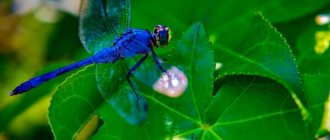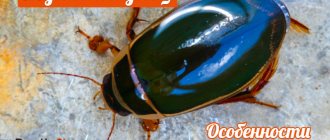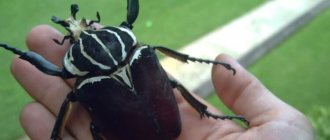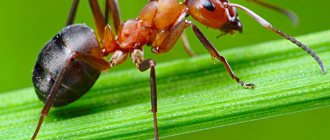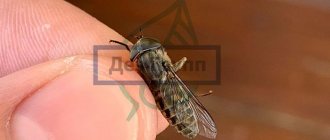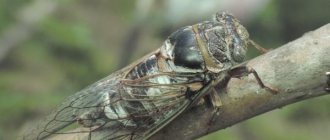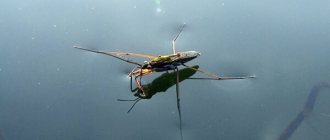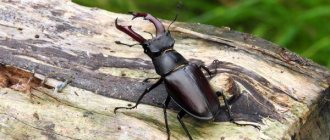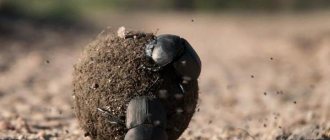You may encounter a gray long-whiskered beetle at your dacha, if, of course, the dacha is located on the edge of a coniferous forest. Most of all, this beetle prefers pine forest or mixed forest with a predominance of Scots pine.
It is on fallen pine trunks or stumps that you can most often see this colorful insect, shown in the following photo.
As you can see in the picture, the long-horned beetle is actually both gray and long-haired, so the beetle fully lives up to its name.
Description and features
These insects are mostly harmless in themselves; they feed on plants, mainly of the woody variety. But sometimes they look very menacing. The most striking feature is the long mobile whiskers, their size is 2 or even 5 times the length of the body. At the base of the antennae are the insect's eyes. The mustache is an organ of smell and touch.
What all these beetles have in common is an elongated body structure, although, depending on the species, the shape itself can be wider at the sides and more elongated. The body structure of adult individuals can be divided into three main parts: head, chest and belly. The limbs are divided into 5 components - pelvis, trochanter, femur, tibia and tarsus.
They have 3 pairs of legs, hard chitinous elytra, and some have large jaws. The abdomen is soft, divided into segments, most often into five. Their head is round in shape and sometimes fits quite tightly into the prothorax.
Males differ from females by having longer mustaches, the upper jaws of males are also more developed, the abdomen is sharper, and they are often painted a different color. Their body shape is more flattened and wider. These beetles are characterized by such a concept as sexual dimorphism. This is when females and males look different, as if from different species.
Many longhorned beetles make sharp sounds, such as squeaking or grinding sounds. This occurs due to friction of the prothorax rib against the rough surface of the mesothorax, or friction of the thighs of the hind legs against the elytra. They make such sounds when there is a threat of attack from enemies. Most likely to scare them away.
Their coloring varies greatly. It consists of the color of chitinous wings and hairs on the body. The colors delight with their diversity. Light shades - creamy yellow, salad, lemon, pink.
Dark shades - brown, purple, black. Combined coloring is very common - stripes, spots and other patterns, sometimes of a complex and ornate shape. All external differences between beetles depend on their habitat and species affiliation.
What happens to the larvae
This can be said about light or milky-colored, fleshy-yellow larvae of a flattened shape. Convex limbs allow future insects to move along the surface. The head is black with healthy jaws. With them they easily gnaw the inside of the tree, so they have enough nutrition. Gradually, only dust remains from the tree trunks. Then the larva will have to look for a new place of “residence”.
Those who live in the grass, on plant stems, have an elongated long body, similar to a cylinder, with hairs at the ends of the body.
Well formed sternum. The gluttony of the larvae is amazing - in a day they can increase their mass to twice their original weight. This law of nature operates to produce a full-fledged beetle, because... on summer days, a mature individual eats practically nothing - just grass and flowers. Moments were noted when bark beetle larvae completely destroyed human wooden buildings located in one block. Autumn is coming to an end. The beginning of winter is the time of pupation of the larvae. Spring is the stage of metamorphosis of a beetle into an adult insect. If the larva is hidden deep in the plant and is reliably protected, then the individual can survive in this state for decades. The fact of drilling a “passage” of up to 50 km has been recorded, taking into account the fact that up to 3 cm of wood is gnawed per day.
The free pupal stage lasts about 40 days. The color of the body changes, yellowness appears, the rudiments of wings and antennae are visible, the limbs are closely pressed. The head is located almost at the chest, the antennae are hidden between the legs. The pupae may have spines and short hairs.
The larva first builds a shelter in a tree trunk, ground, stems, and pupation begins there.
Kinds
Very rough estimates indicate about 26,000 species of these creatures, but these data often change. Almost every year new species are discovered from different places, mainly from the tropics and areas close to the equator. However, new species also appear in civilized Europe, exotic Asia and advanced America.
There are 583 species of them on the territory of Russia. Despite their diversity and abundance, these insects have been well studied by scientists. Most are average in size for beetles. But there are also giants among them. For example, the titan lumberjack, which lives in North America, reaches 19-22 cm in length.
There is another large species in South America - the Brazilian bigtooth woodcutter, the size of which can be 17-18 cm. The longhorned beetle from Fiji is the third largest of the large beetles known at the moment. Its size reaches 15 cm.
Lumberjack bigtooth
Of the European beetles, the largest at the moment is the carpenter's longhorned beetle, it is about 6 cm long. Russia also has a large representative of this species - the Ussuri relict longhorned beetle. He grew to 11 cm.
Relict barbel
There are 11 subfamilies belonging to the barbels. Let's talk about some of them. Their names: true longhorned beetles, laminae, longhorned beetles, parandrins, prionine longhorned beetles, spondylidins. Lamiinae include more than 13,000 species of beetles, many of which look elegant in appearance. For example, some have transverse stripes of black and greenish color along their wings.
Prionins include 1000 species. This is one of the oldest beetles. Found everywhere on earth except cold polar regions. The size varies greatly, from 2 mm to 178 mm, but mostly these are large beetles, sometimes even up to 22 cm.
Painted in brown, black, brown tones. It is to this subfamily that the giants among beetles belong: the titan woodcutter, the Brazilian bigtooth woodcutter and the Ussuri relic woodcutter.
Parandrins number 50 species and live in the tropics and subtropics. They are atypical for the family, as they have very short antennae, which are more reminiscent of staghorns. The color of their hard wings is usually red-brown or black.
The barbels or lepturines are a family of 100 genera and 2500 species. Small beetles, the wings are colored with yellow and black stripes.
Spondylidins include more than 100 species. These are nocturnal and crepuscular representatives. Their whiskers are also not very long, their size is smaller than their body. The color of the wings is blue-black or black-brown.
This longhorned beetle in the photo resembles a picture from Egyptian frescoes. It is very beautifully outlined, there is an interception in the middle of the body, the wings have a noble matte tint, a little like a bronze vase. The whiskers are segmented, the paws are very elegant. Just a model for a coat of arms.
Name
The family name Cerambycidae is a Latin neologism that did not exist in classical Latin, but was created in the time of Carl Linnaeus. It is formed by the comparison of two words: the ancient Greek ceros - “horn” and the Latin bis - “two”, which means “two-horned”. This name reflects the characteristics of the antennae of longhorned beetles - the length and their forward direction during life, associated with horns. In many Western and Central European languages, the name barbel is associated specifically with horns: English. Longhorn beetle, fr. Longicornes, Spanish Escarabajos longicornios, German. Bockkafer, Polish. Kózkowate and the like. At the same time, two distinct names were established in southern and eastern European languages. The first associates antennas with mustaches: Russian. mustache, Ukrainian vusachi, white vusachis and the like. The second is with feeding on wood at the larval stage: Rus. woodcutters, white Dryvaseki, Bulgarian Seckovci, Czech. Tesaříkovití, etc.
Musk barbel
In the Ukrainian language, in addition to the generally accepted and basic name “usachi”, the following are also known: skripuni, skripunuvati, dovgorozhtsi, kovzani and cossacks. The names “skripuni” and “skripunuvati” are associated with behavioral features - suddenly seized imago barbels make a creaking sound, rubbing the pronotum against the mesonotum; the name “Dovgorozhtsi” indicates the similarity of the antennae with horns; “Kovzani” (Russian “skates”) - for the similarity of the antennas with the skates (runners) of a sled; “Cossacks” - for the similarity of the antennae with the long mustaches of the Cossacks.
Lifestyle and habitat
The longhorned beetle lives throughout the planet where there are forests. Their distribution depends on the availability of food - mainly trees. The exceptions are the Arctic and Antarctic, precisely because of the lack of food supply.
They are quite active in their lifestyle. They crawl, many very quickly. Some of them can fly. If you pick up a beetle, it makes a characteristic chirping sound. Their lifestyle depends on the climate and habitat.
In the southern regions, these insects “take wing” from mid-spring. Central Asian beetles begin to fly closer to autumn. Some are active during the day, feeding mainly on flowers that open during the day. Others are active at night. Their food does not hide in the dark.
Both nocturnal and daytime beetles find hard-to-reach places to rest or mate. Depending on the size, the flight range is determined. The larger the beetle, the less it flies and the more it crawls. They lead a very secretive lifestyle. Seeing an adult beetle in the forest is a real gift for an entomologist and an alarming signal for a forester.
Behavior
Beetles are active mainly during the day, slightly less at dusk and at night. The structure of their body allows them to crawl through narrow cracks in the bark and feed on living and dead wood, but they have a clear preference for the latter.
In addition to it, fallen pine needles occupy a significant place in the diet. The bark is eaten last. With a lack of coniferous dead wood, eaters are content with deciduous trees.
While eating, insects periodically make hissing sounds, rubbing the thorax and abdomen with their elytra and hind legs.
The camouflage coloring makes the longhorned beetle unnoticeable on the trunks of fallen trees.
Adults can be observed from March to the end of July. Their numbers peak in April. Sometimes, under favorable conditions, they are observed even in the fall. During spring frosts, gray longhorned beetles burrow into the forest floor.
Nutrition
What the longhorned beetle eats depends on its habitat. Adult beetles feed on pistils and stamens of flowers, young bark and leaves of bushes and trees. Pieces of fallen or healthy bark, petioles, plant sap, pulp of cacti or other plants - this is what the longhorned beetle feeds on.
That is, an adult beetle is almost harmless. But the larva of the longhorned beetle is a scourge for trees, wooden buildings and wooden objects. They develop in trees and feed on wood, causing enormous harm to forests on the planet.
Many beetles were divided into subspecies precisely due to the choice of the type of tree they chose to feed their larvae. For example, the oak longhorned beetle prefers hardwood trees, oak, for example.
It can settle in oak stumps, as well as in places where the tree is damaged. This beetle is medium in size, 3 to 6 cm, black with a brown tint, and glossy like resin. The elytra are reddish at the tips. In addition to oak, he chooses beech, hornbeam, elm, and walnut for feeding future larvae.
The black or pine longhorned beetle prefers to choose coniferous trees. It is also called the ship beetle. Its larva inexorably destroyed even ready-made ship structures if they were built from infected pine. He himself feeds on pollen, pine needles and leaves.
The beetles that prefer coniferous trees for their clutches - larch, spruce, pine, also include the flat beetle, with a purple color.
The purple longhorned beetle itself feeds on the soft bark of young trees and tender young needles. But its larva causes damage to trees on an almost industrial scale. They continue to destroy wood, even harvested and cut for consumption. They also love to live close to humans, destroying buildings.
Underground enemy
Yes, I don't see anything.
It was discovered soon.
the culprit of the death of the coming harvest.
While digging up the garden, a mound of earth suddenly began to move. In the resulting hole, a cute gray muzzle with a lush mustache and a wet pink nose appeared. The animal tore the ground with strong paws with long claws. The husband rushed to the hole, but the uninvited guest quickly buried himself in the sand. Mole holes
That's how we found out
that a dangerous pest has appeared on our site - the European mole. This small animal leads an underground lifestyle.
Moles have a short, thick body
cylindrical in shape, which smoothly goes into the head.
The animal's ear openings are covered with a thick fold of skin. The mole's eyes are small, securely hidden in thick fur. These anatomical features prevent sand from getting into your eyes. Despite the absence of ears, animals have excellent hearing. Mole
Mole coat smooth
and velvety to the touch. The fur does not allow moisture and earth particles to pass through. Such a fur coat does not prevent the mole from moving along long and winding underground passages.
Moles
They love areas with moist, soft soil. They often settle in gardens and orchards. They feed on insects and earthworms. Sometimes they eat plants.
Reproduction and lifespan
The entire breeding process takes place in a quiet and calm place, somewhere higher. On the top of a tree, on the roof. Females secrete a special fluid (secret) that attracts a partner. Mating takes about 30 minutes. The female who has received attention remains under the protection and supervision of the male, who accompanies her until the eggs appear.
At the end of the mating season, the male dies, and the female survives it to lay eggs. The female beetle lays up to 100 eggs in cracks in trees and wood parts. She chooses the laying site by smell. Having created a clutch, the insect no longer shows any concern for the offspring.
Larvae emerge from the eggs, then pupae, and only after a few years do they eat through the passages in the tree and crawl out. The larvae themselves, growing, almost reach the length of an adult beetle. The entire life cycle consists of several stages: egg, larva, pupa, adult.
Sometimes longhorned beetles prepare in advance a place for feeding and development of future larvae. They choose small trees and eat the bark around the perimeter in the form of a ring, closer to the root. As a result, the tree begins to slowly die. And the deposited larvae complete the destructive process.
They make a loud crunching sound as they bite into the wood. Sometimes in a dry forest you can even hear this characteristic sound. The larvae are very hardy. They tolerate any unfavorable conditions and live in dry and nutrient-poor trees for many years.
They have a light body color, from white to yellowish. The body itself is soft, slightly flattened, with a well-developed cephalothorax. It is equipped with powerful jaws directed straight forward, which can perform both cutting and chewing functions.
The life cycle of an adult is quite short. The beetle emerges from the pupa in early spring, although for this the larva must have time to “pupate”. If spring is far away, the pupa burrows into the core of the tree and hibernates, waiting for the onset of warmth.
Prevention measures
To prevent longhorned beetles from causing damage to your structure, you must:
- carry out a thorough inspection of the wood for the presence of holes made by insects,
- if damage is detected, use special protective equipment,
- keep the room dry, since excessive humidity is one of the favorable living conditions for insects,
- for preventive purposes, wooden surfaces must be periodically treated with special insecticidal agents,
- for construction, use material that is not infested with insects, this is easy to verify when the wood is cleared of bark,
- If wooden structures are heavily infested, they should be replaced with new elements.
By periodically carrying out these simple measures, you can protect your home from pests.
https://youtube.com/watch?v=-YvybHrQ2g8%3Frel%3D0
Benefits and harms for humans
When the larva gets out, a hole is formed in the tree, from which small sawdust spills out. This way it becomes clear where this harmful beetle lives. Sometimes they eat the tree from the inside until it is completely rotten, and it collapses.
Some beetles, such as the house beetle, have become unpleasant neighbors for humans. They are rare in nature, but they thrive in wooden houses. The home's upholstery, floors, wood window frames, ceiling rafters and roof can all be damaged if this insect infests. They lay larvae that destroy anything wooden.
Even furniture, beds, tables and chairs, may suffer from such proximity. Beetles prudently lay eggs in hard-to-reach places - deep cracks in wooden products. After 2 weeks, larvae emerge from them, which begin their invisible destructive activities. If these items are not processed in time, after a while everything will turn into dust.
There are, however, individuals of the woodcutter beetle that are not dangerous, but, on the contrary, are beneficial. For example, the gray longhorned beetle is not so harmful to the forest. It only affects old and dying trees, which speeds up the transition of loose wood into humus. Many beetles act as pollinators of flowering plants, providing more benefits than classical pollinators.
What danger do these beetles pose?
The main food of insects is bark and various vegetation.
They do not bite or harm people. But the bark beetle will ruin human property. Becoming a mature individual from a pupa, the beetle makes a move to come out. If rot and white powdery deposits are noticed on wood structures, this is a sign of an undesirable neighbor. In wood inhabited by pests, you can find numerous passages; a sharp object effortlessly enters the thickness of such a tree. When it’s completely quiet, you hear a rustling, clicking sound that resembles ticking. This sound is made by gnawing beetles located behind the bark during the day. At night, “crackling” occurs from larvae that hide in the thickness of wooden objects. The bark beetle will also use its unpleasant creaking tone as a defense when an enemy attacks them. The larva causes the greatest harm to wooden buildings, because it lives inside and destroys the structure. Even after the death of a tree, the larvae continue to live in it, finding food there.
How to get rid of barbel
The longhorned beetle at home is one of the most terrible enemies of man, if not the most dangerous. Its larvae are hardy, voracious, and are not immediately detected. Therefore, you need to know some rules on how to get rid of the longhorned beetle so as not to be left homeless.
- When choosing wood, be sure to check whether it has been treated with an antiseptic.
- When constructing a building, use special finishing products for wood with an antiseptic. They will prevent bugs from invading.
- If you have bugs, be sure to carry out emergency treatment with chemicals. These are bromomethyl, zinc chloride, sublimate. Moreover, such treatment must be carried out 2-3 times a year. The larvae are tenacious, and prevention is a must. It is important to remember that the process must be carried out under the control of the relevant services. It is better to call specialists from the sanitary and epidemiological station for this purpose.
You should also contact specialists if you decide to fumigate against beetles, treat with poisonous gas, or install poisonous baits. All these methods require a careful professional approach.
You can treat it with dry steam or, conversely, by freezing. Only these methods are difficult to implement at home. And they are not safe. Therefore, they are used in production, and only in strictly designated places.
A modern method of getting rid of house beetles is microwave irradiation. A special device heats the wood even in hard-to-reach places, destroying the larvae. The advantage of this method is safety for people and buildings. It happens that some affected parts are easier to cut out and replace with new, undamaged and treated ones.
Preventive actions
A wooden building needs protection from insect pests.
For these purposes, when constructing a facility, provide an obstacle to woodworms. All accessories that are not yet infected (boards, beams, beams, ceilings, etc.) are treated with an antiseptic, and in several layers. Wooden buildings that have been attacked by insects should:
- Treat with dry steam
at 80 degrees. The beams dry out and the larvae die. At the same time, the texture and appearance of the wood are not destroyed + fungus and mold are destroyed, and the nasty smell disappears. Steam is able to penetrate into the most remote corners of the structure. The process is not expensive, but it is fire hazardous. The method is only suitable for attic spaces. - Treat the room using fumigation
, i.e. gas - this effective remedy will protect the tree from bark eaters. You will need a steam supply unit that will penetrate all the cracks of the infected object and kill the larvae. The gas (it is odorless) disintegrates soon and will not harm humans. After treatment, the home is ventilated for two days. - The fogation method
involves fumigating a space using a fog generator. This is a fine spray in the form of an aerosol, which contains a chemical substance. The jet hits only the wooden surface; the interior of the wood is left untreated. - An antiseptic
is poured into the passages gnawed by the larvae using a syringe. The douching method will help at the initial stage, when there are still few pests. As the anti-putrefactive drug evaporates, douching is repeated. - The current method of pest control involves Microwave irradiation
. A special device is installed. It emits waves that heat the surface. The tree becomes hot - insects die in it. Microwave disinfestation works well in areas that are difficult to reach with other methods.
To fully combat lumberjacks in your home, constantly inspect wooden objects to see if any holes or passages have appeared. Frequent ventilation of the home will eliminate excess moisture, which attracts larvae.
Interesting Facts
- Despite its powerful jaws, capable of chewing through a pencil, the beetle's bite is not dangerous to humans. He is not capable of causing him serious harm.
- An adult longhorned beetle, even a giant one, eats very little. Sometimes he lives only thanks to the reserves that he accumulated as a larva. Females feed more than males to ensure normal egg maturation.
- In her territory, the female most often has no rivals. She secretes a special pheromone that attracts males and repels other females.
- A grown beetle lives for one summer season, a maximum of 2-3 months, and the larva is much longer, for years, in some species up to 10 years.
- Some futurists predict that in the future we will eat wood. If you study and use the digestive system of the longhorned beetle, it is quite possible to do this. Its intestines are equipped with special bacteria that process cellulose into easily digestible carbohydrates. Periodically, the larvae process these bacteria, obtaining additional nutrients from them. Waste-free production.
- It may seem strange, but not butterflies and bees, but the longhorned beetle is inextricably linked with flowering plants. They spend most of their short lives on flowers. And because of their size, they pollinate a large surface. Thanks to his taste preferences, some plants have been preserved and survived in nature.
Underground enemy
Yes, I don't see anything.
It was discovered soon.
the culprit of the death of the coming harvest.
While digging up the garden, a mound of earth suddenly began to move. In the resulting hole, a cute gray muzzle with a lush mustache and a wet pink nose appeared. The animal tore the ground with strong paws with long claws. The husband rushed to the hole, but the uninvited guest quickly buried himself in the sand. Mole holes
That's how we found out
that a dangerous pest has appeared on our site - the European mole. This small animal leads an underground lifestyle.
Moles have a short, thick body
cylindrical in shape, which smoothly goes into the head.
The animal's ear openings are covered with a thick fold of skin. The mole's eyes are small, securely hidden in thick fur. These anatomical features prevent sand from getting into your eyes. Despite the absence of ears, animals have excellent hearing. Mole
Mole coat smooth
and velvety to the touch. The fur does not allow moisture and earth particles to pass through. Such a fur coat does not prevent the mole from moving along long and winding underground passages.
Moles
They love areas with moist, soft soil. They often settle in gardens and orchards. They feed on insects and earthworms. Sometimes they eat plants.
Protection of relic woodcutters
Photo: Relic woodcutter Red Book of Russia
The Ussuri longhorned beetle is the smallest species of the longhorned beetle family. Small populations of this insect inhabit broad-leaved, mixed types of forests. Today, this type of insect is protected by law. It is listed in the Red Book of Russia due to a significant decline in populations in their natural habitat. Longhorned beetles are classified in the second category and are recognized as a declining species.
Scientists have named the three most significant reasons for the reduction in the number of relict woodcutters: deforestation, uncontrolled catching of adult individuals by exotic lovers, and deliberate cleaning of forests from pests (woodcutters harm the wood).
The destructive effects of these factors led to the rapid extermination of beetles. Today, relic woodcutters are protected by law. On the territory of their natural range, trapping and hunting of adult beetles is strictly prohibited. If this rule is violated, a person may receive a fine. Longhorned beetles have also been introduced into many Russian nature reserves, where scientists can monitor their populations and more carefully protect them from illegal catching. In addition, the government began to control deforestation in order to preserve the habitats of these insects.
The relic woodcutter is one of the most unique species of longhorned beetles; it is a very large and beautiful representative of beetles. Large dimensions, extraordinary appearance, long mustache - all this makes this insect unique in its kind. This is not to mention the fact that it itself is recognized as a living “fossil”. Unfortunately, in recent years the number of these beetles has decreased significantly. All this requires people to quickly take effective measures to protect woodcutters in their natural habitat.
Shashel
Chashel often refers to beetles that damage furniture. Often all these insects are referred to by one term, although in fact the shashel is a black barbel. Externally, longhorned beetles differ from other grinders in appearance. They are black, with whitish patches, and have a large head with antennae and wings. Body length – 15-40 mm.
The difference between them and other insects that attack wood is that they prefer coniferous trees - fir, spruce. They live mainly in coniferous and pine forests.
The methods of control are the same as with other beetles that damage wood. They love fresh wood and can be found in warehouses, from where they enter homes.
No. 4 [Forest Bulletin. Forestry Bulletin, 2011]
Previous name: Bulletin of the Moscow State Forestry University - Forest Bulletin (until 2016) / The journal is a leading scientific and information journal in the field of forestry, ecology, logging, woodworking, chemical technology and wood processing, economics of the forestry complex. The magazine publishes: articles by scientists of higher education, research institutes, foreign specialists, business managers and engineers; texts of scientists' reports at symposia, conferences and meetings; annotations and reviews of new books; journalistic and historical literary materials. Editor-in-Chief - Oblivin Alexander Nikolaevich, Professor, Doctor of Technical Sciences, Academician of the Russian Academy of Natural Sciences and MANVSH, Honored Worker of Science and Technology of the Russian Federation, President of Moscow State University of Forestry, Professor of the Department of Processes and Devices of Woodworking Production, Moscow State Forestry University
18 Acanthocinus aedilis L. long-nosed barbel C, K, less often xv. ks + + + 19 A. griseusFgray long-whiskered woodcutter Thus, long-whiskered long-horned beetle, pine, spruce, large pine weevil, pine gum weevil, small forest windfall of the second and third year are also inhabited in small numbers by tertiary pests - gray long-whiskered
Preview: Bulletin of the Moscow State Forestry University - Forest Bulletin No. 4 2011.pdf (0.8 Mb)
No. 3 [Bulletin of Tomsk State University. Biology, 2016]
The scientific journal was separated into an independent periodical publication from the general scientific journal “Bulletin of Tomsk State University” in 2007. Published quarterly. Included in the List of Higher Attestation Commissions
In general, the fragments of long-whiskered and short-whiskered dipterans are similar. Small scales of representatives of long-whiskered dipterans of the Diptera family (Chironomidae) were found in large quantities in the samples; e – antennae of long-whiskered dipterans (Сhironomidae); f – the base of the antennae of the Diptera Thus, on the territory of Poland, the most important component of the diet of the two-colored leatherback is considered to be long-whiskered. The most common and most abundant are long-whiskered Diptera, beetles and homoptera (cycads).
Preview: Bulletin of Tomsk State University. Biology No. 3 2016.pdf (1.0 Mb)
Life cycle
The development of the beetle takes 2 years, and in unfavorable conditions it can take 3 years. The first longhorned beetles appear in May, but the main years are in June. Before laying eggs, they require additional nutrition on young twigs and needles. The fertilized female makes incisions in the bark, into which she lays white oblong eggs. Young larvae begin constructing tunnels in the bark. By autumn they go deeper into the tree trunk. The larva is white, legless, moves with the help of warts on the first 7 abdominal segments. In a special recess covered with sawdust, the larva pupates. The young beetle climbs out of the trunk through a hole in the bark.
No. 10 [Aviation collection, 2011]
Supplement to the magazine “Modelist-Constructor”, published since July 2003. A specialized magazine for fans of aviation history and aircraft modellers.
Each issue is a mini-monograph about domestic or foreign aircraft designs. Each issue contains information about the history of the creation of an airplane or helicopter, its mass production, modifications, operation, combat use and painting.
A brief technical description and drawings of the machine are provided. As well as a large number of photographs, including photographs of components and assemblies. TRANSFER OF SUBSCRIBER NUMBERS IS CARRIED OUT WITH A DELAY OF 12 MONTHS!!!
The car was dubbed “Asterix” for its resemblance to the long-moustached hero of popular French cartoons and comics.
Preview: Aviation collection No. 10 2011.pdf (0.1 Mb)
A little bit of biology
Longhorned beetles have fairly small sizes (from one to several tens of millimeters), a flat body and mustaches, which are the main organ of smell. The color of lumberjacks is usually brown or dirty gray; less commonly, the longhorn beetle is black. The photo allows you to examine the insect in more detail.
The larvae of the pest are characterized by particularly powerful jaws, thanks to which they can handle both hard wood and soft metal with a cable-type coating. However, the beetles do not eat the latter so readily, preferring wooden structures and stacked boards.
The female barbel lays her eggs (from 200 to 400 pieces) in recesses or cracks in the tree, and after 7-14 days the larvae are born, which instantly activate the process of destroying the tree.
It is worth emphasizing that it is almost impossible to immediately notice a tree disease, since the larvae lead a hidden lifestyle. So, you can understand that your wooden house has succumbed to the harmful effects of longhorned beetles only when the real results of their work (destroyed and loosening wood) are visible.
General entomology: guidelines for practical work
RIC SSAA
The guidelines contain sections on the main groups of animals that are of practical importance in plant protection. The educational publication presents the features of the relationship between animals and cultivated plants; morphological, anatomical and physiological features of the structure of insects; individual embryonic and postembryonic development; annual cycles of insect development, methods for compiling a phenocalendar and bioclimogram of insect development; taxonomy of insects with incomplete and complete metamorphosis; main types of damage to cultivated plants by pests; economic thresholds of insect harmfulness.
Includes two suborders: long-whiskered (antennae longer than the body) and short-whiskered (antennae are usually no longer than half). The long-whiskered families include grasshoppers, false grasshoppers, mole crickets and crickets, and the short-whiskered families include locusts. Two suborders: long-whiskered, or mosquitoes (Nematocera) and short-whiskered, or flies ( Brachycera).
Preview: General entomology guidelines for practical work .pdf (0.6 Mb)
No. 1 [Engineering and technical support of the agro-industrial complex. Abstract Journal, 2010]
The quarterly abstract journal is a body of current information about domestic and foreign documents on the engineering and technical system of the agro-industrial complex. Published since 2000. The annual volume is about 1200 publications. Materials for the publication are selected from current receipts in the reference and information fund of the Federal State Scientific Institution "Rosinformagrotech" and the Central Scientific Research Center of Agricultural Sciences of the Russian Agricultural Academy. The publication is intended and can serve as a reference guide for scientists and practitioners, specialists from government bodies, enterprises and organizations of the agro-industrial complex, university teachers, as well as librarians and employees of scientific and technical information bodies. The RJ includes information about the most scientifically significant book publications and articles from periodicals and ongoing publications, thematic collections on agricultural mechanization, problems of creation, production, use and maintenance of machinery and equipment for the agro-industrial complex.



